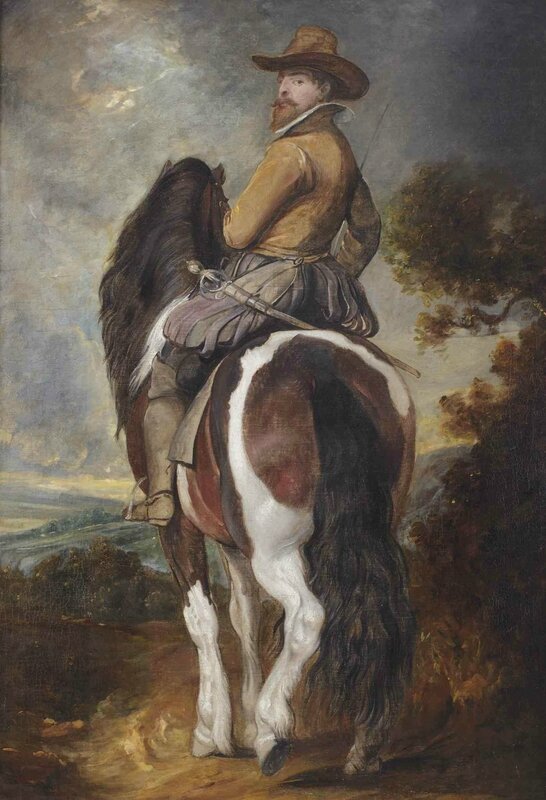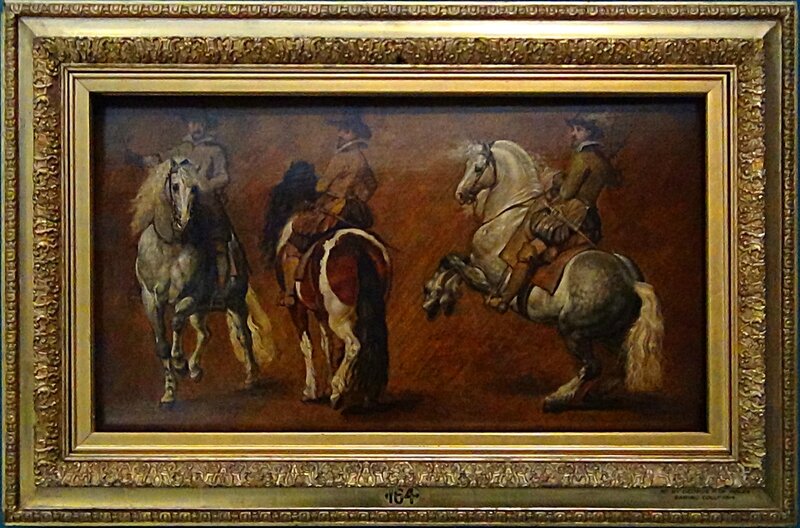Sotheby's. Master Paintings & Sculpture Evening Sale, New York, 25 Jan 2017, 06:00 PM
10 janvier 2017
Sir Peter Paul Rubens (Siegen 1577 - 1640 Antwerpt), Study of a Horse with a Rider
Lot 17. Sir Peter Paul Rubens (Siegen 1577 - 1640 Antwerpt), Study of a Horse with a Rider, oil on canvas, 46 1/2 by 22 in., 118 by 56 cm. Estimate 1,000,000 — 1,500,000 USD. Photo: Sotheby's.
Provenance: Possibly With Galerie Georges Petit, Paris;
Lucien Lambiotte, Brussels, by 1955;
Eric Lippens, Vlezenbeek, Belgium;
Anonymous sale, Amsterdam, Christie’s, 23 June 2015, lot 11 (as After Sir Anthony Van Dyck, measuring 118 by 82 cm., with later additions);
There purchased by the present owner.
Exhibited: Genoa, Palazzo dell’Academia, Cento Opere di Van Dyck, June - August 1955, no. 5 (as by Sir Anthony van Dyck).
Notes: This newly discovered work is a rare example of a large-scale animal study by Rubens. Until recently, the painting had been associated with Sir Anthony Van Dyck, and was exhibited as a work by that artist in Genoa in 1955. However, the picture’s attribution has been impossible to discern with any certainty until now, thanks to a later added background that all but overwhelmed the original (fig. 1). The removal of this later addition has revealed a work of high quality, and a typical example of the spirited and rapidly painted oil sketches – seemingly "drawn by the brush" – for which Rubens is so celebrated.
The painting can be dated to the early 1610s, when Rubens made a series of equestrian studies for use in both portraits and subject pictures. Such studies were required to help him cope with the increasing demands on his time. By his mid-thirties Rubens was one of the leading painters in Northern Europe, and commissions flooded in. To maximize his output he began to rely on studio assistants to help him, and key to guiding them wasa large number of studies by Rubens himself like the present example. Today, Rubens’ best known studies are the characterful heads designed to be repeated (or in modern parlance "cut and pasted") in multi-figural compositions. As a result, we often see the same characters appear with unnerving regularity in Rubens’ larger works (and sometimes even within the same painting).1
But the same was true of Rubens’ equestrian studies. For example, the same horse in the same pose can be seen in a number of Rubens’ equestrian portraits from this stage of his career, including his 12 foot high Portrait of Don Rodrigo Calderon on Horseback dated to 1612-15 (fig. 2, Royal Collection),2 the lost circa 1615 Portrait of Albert, Archduke of Austria,3 and the slightly later Portrait of Ladislas-Sigismund, Prince of Poland (Wawel Castle, Cracow).4 The two extant portraits are today believed to have been painted with significant studio assistance. Since such large works would have been among the most complex for Rubens’ assistants to master it is hardly surprising that he sought to replicate a well-established pattern through the repeated use of one original study, which would be copied and scaled up by assistants. Rubens would then apply much of the final detail himself. A concession to originality in such pictures was to change the color of the horse from grey to brown.
Fig. 2. Peter Paul Rubens, Portrait of Don Rodrigo Calderon on Horseback, oil on canvas / Royal Collection Trust © Her Majesty Queen Elizabeth II, 2016 / Bridgeman Images
But the original studies on which Rubens’ early equestrian works were based has until now remained something of a mystery. Three of the poses he used most often have been known through a now lost painting formerly in the Kaiser Friedrich Museum in Berlin, which was traditionally called The Riding School.5 In 1987 Hans Vlieghe recognized that the Berlin picture was not in fact intended to show an actual riding school, but was perhaps instead a “studio ‘prop’ [to be used] whenever an equestrian portrait was called for.”6 The Berlin picture showed three horses arranged together on a single canvas, on a landscape background, and in the three "attitudes" 17th Century viewers might have expected to see horses performing. The horse on the left was that used in the above mentioned equestrian portraits. The central horse is a semi-rearing grey horse in profile (performing a pesade), which can be seen in the large Wolf and Fox Hunt of about 1616 (New York, Metropolitan Museum of Art) painted by Rubens and his studio.7 The horse on the right showed a "piebald" horse from behind. This pose, evidently unsuitable for both portraits and hunting compositions, is only known to have been used once by Rubens: in the foreground of his circa 1630 Henry IV at the Siege of Amiens in the Gothenburg Museum of Art (fig. 3).8
Publicité
Publicité
Commentaires

/https%3A%2F%2Fprofilepics.canalblog.com%2Fprofilepics%2F1%2F0%2F100183.jpg)
/https%3A%2F%2Fstorage.canalblog.com%2F03%2F02%2F119589%2F96711876_o.jpg)
/https%3A%2F%2Fstorage.canalblog.com%2F11%2F31%2F119589%2F94773502_o.jpg)
/https%3A%2F%2Fstorage.canalblog.com%2F20%2F83%2F119589%2F94772815_o.jpg)
/https%3A%2F%2Fstorage.canalblog.com%2F26%2F72%2F119589%2F75604929_o.jpg)
/https%3A%2F%2Fstorage.canalblog.com%2F59%2F60%2F119589%2F26458628_o.jpg)








/http%3A%2F%2Fstorage.canalblog.com%2F19%2F23%2F119589%2F128179837_o.jpg)
/http%3A%2F%2Fstorage.canalblog.com%2F91%2F05%2F119589%2F127218856_o.jpg)
/http%3A%2F%2Fstorage.canalblog.com%2F34%2F19%2F119589%2F120673279_o.jpg)
/http%3A%2F%2Fstorage.canalblog.com%2F85%2F03%2F119589%2F120567566_o.jpg)